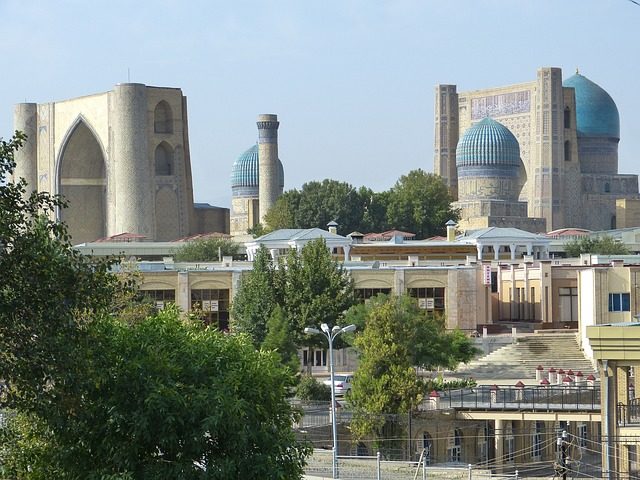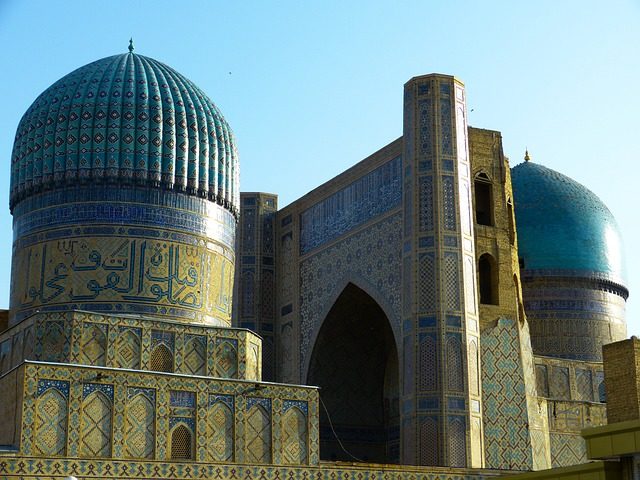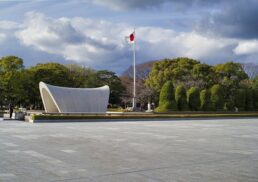Imagine a city where the sands of time have left behind a rich tapestry of history, culture, and architectural wonders. A city that has mesmerized travelers for centuries and once stood at the crossroads of the ancient Silk Road. Welcome to Samarkand, Uzbekistan, a UNESCO World Heritage Site that offers a fascinating journey into the heart of Central Asia.
Table of Contents
Key Takeaways
Discover the ancient city of Samarkand, renowned for its architectural masterpieces and vibrant cultural heritage.
Explore local life in Samarkand’s bazaars, parks and neighborhoods or savor traditional cuisine at restaurants & cafes.
Enjoy day trips to nearby attractions such as Shahrisabz and Ulugh Beg Observatory with their own unique historical experiences.
Discovering the Ancient City of Samarkand

Samarkand, also known as Samarkand City, is one of the oldest cities in Central Asia, with a history dating back more than two and a half millennia. The city has been continuously inhabited and has witnessed the rise and fall of numerous empires. Ancient Samarkand was founded between the 8th and 7th centuries BCE, according to several theories. The city, known as Markanda at the time, was subjugated by Alexander the Great in 329 BCE.
This splendid city, an ancient silk road city, has been a melting pot of world cultures throughout its long and storied history. As a vital stop along the ancient Silk Road, Samarkand was the epicenter of trade and cultural exchange between various trade routes, connecting:
China
India
Persia
The Mediterranean world
The city’s significance as a UNESCO World Heritage Site is due to its remarkable collection of architectural masterpieces, showcasing the pinnacle of Islamic art and architecture.
Samarkand, a medieval city steeped in history, harbors a wealth of archaeological assets, among which the Afrosiab Reserve provides a window into its far-off past. The old town still holds a wealth of history. Narrow lanes separate its different districts, spotted with social centers, mosques, madrassahs and residential housing. The impact of the Timurid masters on the Islamic architecture and arts is evident throughout Samarkand, as their influence extended across the region, shaping the accomplishments of the Safavids in Persia, the Moghuls in India, and the Ottomans in Turkey.
As you walk through the city in north eastern Uzbekistan, you will find yourself transported back in time, marveling at the majestic monuments that continue to captivate visitors from around the world. One such monument is the statue of Amir Timur, one of Uzbekistan’s preeminent rulers, symbolizing the city’s splendor situated at the end of University Boulevard Street.
The blend of antiquity and modernity is clear in today’s Samarkand, which flourishes as a hub for education, science, and cultural dialogue. University Boulevard is a 128-meter-long street lined with oak and plane trees, serving as the city’s educational and scientific hub.
Navigating Samarkand: Getting There and Around
Embarking on your adventure to the ancient city of Samarkand requires some navigation to reach this enthralling destination. The most convenient and expeditious method of traveling to Samarkand from other cities in Uzbekistan is by train. The Afrosiyob and the Sharq are two trains that operate between Bukhara and Samarkand, connecting these ancient Silk Road cities. You can conveniently access train schedules on the official Uzbek Railways website. Tickets can be easily booked from the same platform..
Upon reaching Samarkand, a variety of transportation choices are available for discovering the city and its numerous attractions. Taxis are widely available and offer a convenient way to travel around the city, with the customary rate being 8000 UZS. It is also possible to take a taxi from the train station to the city center, with fares typically not exceeding 20000 UZS. For those who prefer to use public transportation, buses and marshrutkas (minibuses) are also available.
As you map out your trip to Samarkand, remember to choose a mode of transportation that best suits your needs. Rail travel is recommended for traversing Uzbekistan, as it offers a comfortable and efficient way to explore this fascinating country.
With your transportation sorted, you can focus on immersing yourself in the rich history, stunning architecture, and vibrant local life that Samarkand has to offer.
The Perfect Time to Visit Samarkand
Planning your trip to Samarkand during the most agreeable time of year is key to maximizing your visit. The ideal time to visit the city would be during early autumn (September and October) and spring (April and May). During these seasons, the weather is pleasant and you can enjoy Samarkand’s attractions without contending with extreme temperatures.
While summers in Samarkand can be quite hot, with temperatures ranging from 35°C to 40°C and sometimes even higher, winters offer a more pleasant climate. If you are fortunate, you may be able to witness the city’s beautiful architecture covered in snow.
Regardless of the season, Samarkand’s stunning architectural wonders and vibrant local life are sure to leave a lasting impression on any traveler.
Unveiling the Architectural Wonders of Samarkand

One of the greatest delights of visiting Samarkand is exploring its stunning architectural masterpieces, which include:
Registan Square
Gur-e-Amir Mausoleum
Bibi Khanym Mosque
Shah-i-Zinda Complex
These magnificent structures showcase the pinnacle of Islamic art and architecture, reflecting the city’s rich cultural heritage and its pivotal role in the history of Central Asia.
Registan Square
Registan Square, the heart of ancient Samarkand, is an iconic symbol of the city and a widely visited tourist destination. The square is renowned for being surrounded by three madrasahs (Islamic schools): Ulug-Beg, Tilya-Kori, and Sher-Dor, each showcasing unique architectural elements and intricate tilework.
The name “Registan” means “sandy place” or “desert” in Persian and served as a public square where people would assemble to engage in trade, listen to proclamations, and witness executions. Today, Registan Square continues to captivate visitors with its magnificent architecture and the grandeur of its three madrasahs, offering a glimpse into the city’s glorious past.
When planning your visit to Registan Square, consider:
Visiting during sunrise or sunset, as the light during these times beautifully illuminates the intricate tilework and domes of the madrasahs.
The square is open daily from April to October from 8.00 am until 7.00 pm and from November to March from 9.00 am until 5.00 pm.
There is an admission fee of 50,000 UZS.
Gur-e-Amir Mausoleum
The Gur-e-Amir Mausoleum is the final resting place of Amir Timur, one of the most influential rulers in the history of Central Asia. This architectural masterpiece features an impressive turquoise dome and elaborate tilework, reflecting the beauty and grandeur of Islamic art and architecture.
The mausoleum, one of the stunning ancient monuments, has an exterior decorated with blue, turquoise, and white tiles. These tiles are fashioned into geometric and epigraphic designs against a terracotta brick background. The interior is even more spectacular, with geometric panels radiating with stars, niches adorned with stalactites molded from papier-mache painted blue and gold, and an intricate gilded coating around high lattice windows.
Visiting Gur-e-Amir Mausoleum is an unforgettable experience, offering a glimpse into the life and legacy of Amir Timur. The mausoleum is open daily from April to October from 8.00 am until 7.00 pm. From November to March, the opening time is changed to 9.00 am until 5.00 pm. An admission fee of 50,000 UZS is required.
Bibi Khanym Mosque
The Bibi Khanym Mosque, named after the wife of Timur the Great, is renowned as one of the most impressive monuments in Samarkand. This ambitious construction project was initiated by Timur himself to create one of the largest mosques in the Islamic world.
However, the mosque experienced structural issues due to the advanced techniques employed in its construction, and it was further damaged by an earthquake in 1897. Despite these challenges, the mosque has undergone extensive restoration efforts to preserve its architectural splendor, with its blue dome and intricate tilework remaining a testament to the skill and ambition of its builders.
Visiting the Bibi Khanym Mosque offers a unique opportunity to marvel at the grandeur of Islamic architecture and the ambitious vision of Timur the Great. The mosque is open from April to October from 8.00 am to 7.00 pm. From November to March it opens from 9.00 am to 5.00 pm.
Shah-i-Zinda Complex
The Shah-i-Zinda Complex, which includes the Hazrat Khizr Mosque, is a sacred necropolis composed of a sequence of blue tombs and several mausoleums situated along a confined avenue. This stunning complex is dedicated to nobles and royals, including Kusam ibn Abbas, a cousin of the Prophet Muhammad.
The name Shah-i-Zinda translates to “the Living King” in Persian, reflecting the enduring legacy of those interred within the complex. As you wander through the maze of tombs and mausoleums, you will be captivated by the intricate tilework and stunning architecture that adorns each structure.
The Shah-i-Zinda Complex is open daily from 7.00 am until 7.00 pm, allowing ample time to explore the sacred grounds and pay tribute to the historical figures who rest within its walls.
Experiencing Local Life in Samarkand
To truly immerse yourself in the vibrant local life of Samarkand, venture beyond the city’s architectural wonders and explore its bustling bazaars, parks, and neighborhoods. One such market is the Siyob Bazaar, the largest bazaar in Samarkand, offering a wide variety of items for purchase, including:
food
spices
nuts
candy
fruits
vegetables
The Siyob Bazaar is open seven days a week, except on Mondays. Operating times are from 5.00 am to 7.00 pm.
While shopping at Siyob Bazaar, be prepared to bargain, as foreigners may be charged higher prices. Engaging in friendly haggling is not only a way to get a better deal on your purchases but also an opportunity to interact with locals and gain a deeper understanding of their customs and traditions.
Another way to experience local life in Samarkand is by visiting the city’s parks and green spaces. Take a leisurely stroll through one of the many parks, where you can relax, enjoy the scenery, and observe locals going about their daily routines.
In addition to parks and bazaars, explore the city’s residential neighborhoods, where you can witness the unique architectural styles of Samarkand’s traditional homes. These dwellings, constructed from mud brick and featuring painted wooden ceilings and wall decorations, offer a glimpse into the daily lives of the city’s residents and provide a unique perspective on city dating.
Savoring Samarkand’s Cuisine: Top Restaurants and Cafes
A day spent uncovering the architectural marvels and lively local culture of Samarkand will no doubt leave you hungry. Indulge in the flavors of Samarkand by dining at top restaurants and cafes, offering a mix of traditional Uzbek cuisine and international dishes.
Some recommended eateries in Samarkand include:
Labi G’Or, serving traditional Uzbek cuisine
Blues Cafe and Platan, both offering international dishes
Bibikhanum Teahouse, serving Uzbek dishes with vegetarian options in a pleasant garden setting
Old City Restaurant, offering a mix of Uzbek, European, and vegetarian cuisine.
Whether you’re in the mood for a hearty Uzbek meal, a light bite with international flavors, or a refreshing beverage in a cozy cafe, the culinary scene in Samarkand is sure to satisfy your cravings and provide a delicious end to your day of exploration.
Where to Rest Your Head: Accommodation Options in Samarkand
Following a day of traversing the ancient cityscape of Samarkand, a cozy spot to relax and rejuvenate will be a necessity. The city offers a variety of accommodation options, ranging from hostels and guesthouses to high-end hotels, catering to different budgets and preferences.
For budget-conscious travelers, consider staying at Amir Hostel, a recommended hostel in Samarkand. If you prefer a more upscale experience, the Platan hotel and Alisher Hotel are both situated within walking distance of Registan Square and Samarkand’s main attractions. For a more intimate and personalized experience, consider booking a room at Sangzor Boutique Hotel, offering various amenities and a cozy atmosphere.
When choosing your accommodation in Samarkand, it is advisable to stay in the city center near Registan, ensuring easy access to the city’s main attractions and vibrant local life.
Capturing Memories: Photography Tips and Gear for Samarkand
In order to encapsulate the splendor of Samarkand and its architectural gems, aim to create breathtaking photographs that truly represent this extraordinary city. Here are some tips and gear recommendations to help you take your photography to the next level.
First and foremost, consider the optimal time for photography in Samarkand. Sunrise and sunset offer the most advantageous lighting conditions, casting a warm glow on the city’s stunning architecture and minimizing the presence of other tourists in your shots. In terms of gear, bring a wide-angle lens, a tripod, and a polarizing filter to help you capture the city’s breathtaking landscapes and intricate details.
When composing your shots, experiment with different angles and perspectives to showcase the city’s unique architectural elements. Utilize the rule of thirds to create balanced and dynamic compositions that draw the viewer’s eye through the image. By following these tips and investing in the right gear, you’ll be well-equipped to capture the essence of Samarkand and its timeless beauty.
Day Trips from Samarkand: Exploring the Surrounding Region
Beyond Samarkand’s own plethora of sights and experiences, contemplate exploring the neighboring areas. One such day trip is to the ancient city of Shahrisabz, located 88 kilometers south of Samarkand. This historic city is home to a number of stunning architectural wonders, including the Ak-Saray Palace, the Darut-Tilavat Madrasah, and the Kok-Gumbaz Mosque.
Another fascinating day trip is to the Ulugh Beg Observatory, constructed in the 1420s by the Timurid ruler Ulugh Beg, the grandson of Amir Timur. This remarkable observatory was once a hub for some of the most eminent astronomers of the time and featured a monumental 40-meters tall meridian arc for calculating the angle of elevation of celestial objects. Today, the observatory operates as a museum, where visitors can observe a model of the ancient observatory and the remnants of the Meridian arc.
To make the most of your day trips from Samarkand, be sure to plan your transportation carefully. Taxis and marshrutkas (minibuses) are available for travel between cities, offering a convenient and flexible way to explore the region.
Check out Samarkand, Uzbekistan – Travel.
Summary
With its rich history, stunning architecture, and vibrant local life, Samarkand truly is a treasure trove of experiences waiting to be discovered. From exploring the city’s architectural wonders and bustling bazaars to savoring its delicious cuisine and capturing memories through photography, there is something for every traveler to enjoy in this ancient Silk Road city. So pack your bags, and embark on a journey to uncover the timeless beauty and enchanting allure of Samarkand.
Frequently Asked Questions
Why is Samarkand so famous?
Samarkand is renowned for its long history as a major trading post along the Silk Road, being founded in the 7th century BC and later becoming an important export centre. It has also been noted for its craft production and strong fortifications since before its conquest by Alexander the Great.
Is Samarkand the oldest city in the world?
Samarkand is one of the oldest cities in the world, with a history going back to remote days. As other first centers of human civilization, it has gone through many events and shakes throughout the centuries. It is a city of great beauty and culture, with many monuments and buildings that have been preserved for centuries. It is also a city of great diversity, with many different ethnic and religious groups living together
What does Samarkand mean in history?
Samarkand is one of the oldest cities in the world, with a history stretching back over 2750 years. The city’s name comes from the Sogdian words ‘samar’, meaning “stone” and ‘kand’ meaning “fort, town”. It has always been distinguished by the fact that it was a true example of oriental hospitality, with several nationalities coexisting with ease.
Is Samarkand part of Russia?
Samarkand was part of Russian Imperial rule from 1868 until the dissolution of the Soviet Union, after which it became part of Uzbekistan’s sovereignty.
How old is the city of Samarkand?
Samarkand is one of the oldest cities in Central Asia, having been founded around 2,500 years ago.









